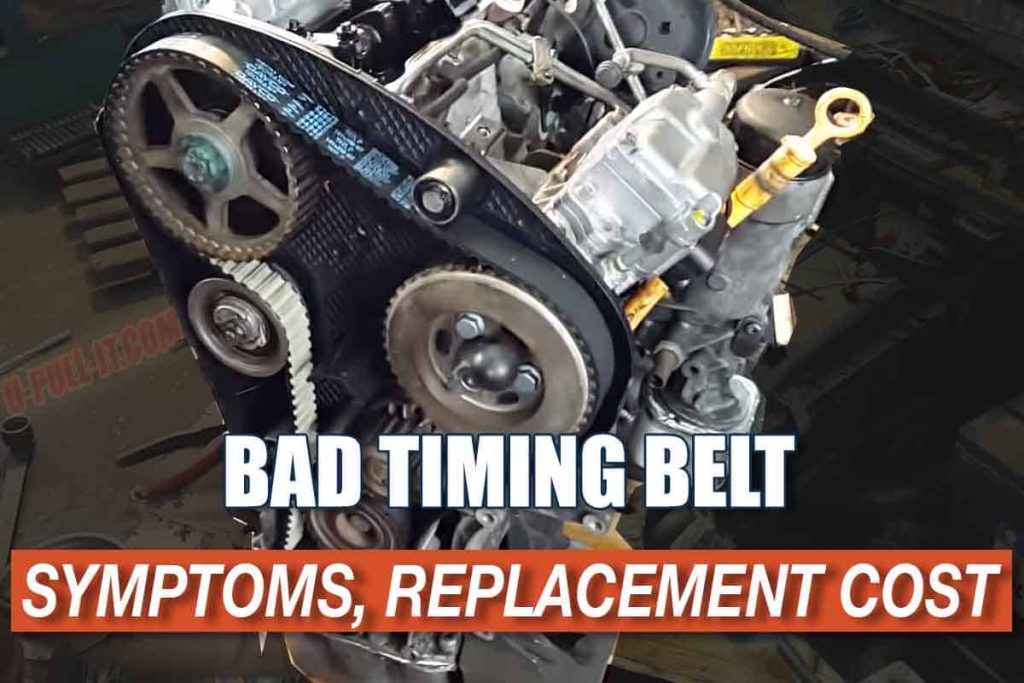The serpentine belts, including the timing belt, play a crucial role in the functioning of a vehicle’s engines. They are essential for the alternator and require a skilled mechanic for maintenance. The rubber timing belt in engines is responsible for the mechanical timing, synchronizing the rotation of the camshafts and crankshaft, ensuring that the valves open and close at the correct time.
However, like any other parts in a car engine, timing belts can wear out over time and must undergo a chain replacement by a mechanic. In this article, we will discuss the common symptoms of a bad timing belt in your car engine, when is the right time for it to be replaced, and what to do when your check engine light may indicate a change is needed. We’ll also compare the cost of replacement, the difference between a timing belt and a timing chain, and whether or not you can replace it yourself.
The cost of replacing a car’s timing belt can vary depending on the make and model of the car as well as the brand of parts used. Typically, a timing belt kit will cost between $100 and $350, while the timing belt itself can range from $12 to $200. Labor costs for timing belt replacement are usually between 3-5 hours, bringing the total cost to between $400 and $1,000.
What are the symptoms of a bad timing belt?

Common symptoms of a bad timing belt
A bad timing belt in your car can exhibit a variety of symptoms, such as a check engine light, indicating it may need a chain replacement, especially in an interference engine. One common symptom is a misaligned or shaky engine. This can happen when the car’s timing belt, or serpentine chain, has jumped a place, causing the engine’s timing to be off. Another symptom of a broken timing belt, serpentine belt, or drive belt is a high-pitched squealing noise coming from the engine.
This could also indicate an issue with the rubber timing belt. This can occur when the serpentine timing belt, akin to a chain, is worn out and is slipping or rubbing against other engine components. Additionally, if you experience difficulty starting your car or notice decreased engine performance, it could be a sign of a bad timing belt or issues with your chain or serpentine system.
The engine is idling roughly.
Timing belts, often chain or serpentine types, have teeth which engage with gears to coordinate the rotation of different engine parts and components. Should these teeth begin to deteriorate or fall off, the timing belt, similar to a chain or serpentine, will lose its grip on the gears.
When this occurs, the dislodged teeth from the rubber timing belt will land directly onto the gears of the serpentine belt, causing a jolt in the engine’s drive belt and chain. The most severe consequence of a faulty drive belt or serpentine belt is that the engine will start to stall due to the chain and camshaft timing being disrupted.
The engine is experiencing misfires.
The engine’s firing rate could be compromised if the serpentine chain, acting as a timing belt, is worn out. Should the timing belt, a crucial part of the engine’s chain, slip off the gears and land on the serpentine camshaft, it may cause one of the cylinders to open and close prematurely.
In such a scenario, the engine might misfire, indicating that the serpentine belt in the chain requires immediate replacement. A delay in replacing the serpentine chain belt could lead to irreversible engine damage.
The engine is emitting smoke.
During the cold winter months, it can be tricky to discern whether the abundant smoke from your tailpipe is just harmless steam or water vapor or if it’s a sign of a failing serpentine belt or chain. However, if you notice an excessive amount of unusual smoke even for a winter chain of events, it could be indicative of a serpentine timing belt issue.
Each cylinder, linked in a chain, has two openings at its top for releasing exhaust and admitting air, regulated by the serpentine belt. The operation of these openings is aligned with the movement of the cylinders, the rotation of the camshaft, and the serpentine belt and chain.
In case of a worn-out timing chain or belt, this alignment gets disrupted, causing the exhaust to be released and air to be admitted at the wrong intervals. Consequently, a significant amount of smoke will be emitted from your exhaust system if the serpentine belt or chain is compromised.
Huge Decline in Oil Pressure
The timing belt, a crucial part of the chain, is responsible for turning the camshaft’s gears. If the timing belt or chain is misaligned, it can skip, causing fragments to break off from the camshaft. Some of these fragments from the serpentine belt or chain may end up in the vehicle’s oil pan, leading to a drop in oil pressure at the engine’s base.
This scenario can result in a complete engine failure. The sole recourse to rectify a faulty serpentine belt or chain is to rebuild the entire engine.
Broken Pistons or Valves
The most severe symptom you could encounter is a snapped or entirely broken timing belt, often referred to as a chain. In such an event, the crankshaft will rotate independently, losing synchronization with the serpentine belt and the camshaft’s movement.
This desynchronization of the serpentine belt will cause the piston to collide with the valves as they open, which could result in bent valves or a damaged piston.
To prevent exacerbating the damage to your engine, it’s crucial to turn off the engine immediately upon experiencing a symptom related to the serpentine belt. Taking prompt action may help you avert major engine damage.
Signs of a bad timing belt
In addition to the common symptoms mentioned above, there are a few other signs that may indicate a bad timing belt. These include an illuminated check engine light, oil leaking from the timing belt cover, or visible cracks or fraying on the belt itself. It is important to address these signs as soon as possible to prevent further damage to your engine.
Timing belt replacement cost
The cost of timing belt replacement can vary depending on several factors. These include the make and model of your vehicle, labor costs in your area, and whether or not any additional repairs or replacements are necessary. On average, the cost to replace a timing belt ranges from $400 to $1000. However, this cost can increase if other components, such as the water pump or tensioner, also need to be replaced.
When should a timing belt be replaced?

How often should a timing belt be replaced?
The timing belt is a wear item and should be replaced according to the manufacturer’s recommended maintenance schedule. In general, it is recommended to replace the timing belt every 60,000 to 100,000 miles or every 5 to 7 years, whichever comes first. However, it is important to check your vehicle’s owner’s manual for the specific recommendations for your make and model.
When to replace a timing belt
There are a few signs that indicate it is time to replace your timing belt. If you notice any of the symptoms mentioned earlier, it is important to have your timing belt inspected and replaced if necessary. Additionally, it is recommended to replace the timing belt when it’s due according to your vehicle’s maintenance schedule. Neglecting to replace a worn or damaged timing belt can result in serious engine damage if the belt breaks while the engine is running.
What happens if a timing belt breaks?
If a timing belt breaks while the engine is running, it can cause significant damage to the engine. The valves and pistons can collide, leading to bent valves, damaged pistons, and potentially a ruined engine. This can result in costly repair bills and the need for a complete engine overhaul or replacement. Therefore, it is crucial to replace the timing belt before it reaches the end of its lifespan to avoid such catastrophic consequences.
How much does it cost to replace a timing belt?

What is the average cost to replace a timing belt?
The average cost to replace a timing belt can vary depending on the factors mentioned earlier. On average, it can range from $400 to $1000. However, the cost can increase if additional repairs or replacements are necessary. It is recommended to get a few quotes from trusted mechanics in your area to get a more accurate estimate for your specific vehicle.
Cost of replacing a timing belt
The cost of replacing a timing belt includes both the cost of the belt itself and the labor costs associated with its replacement. The timing belt is usually an affordable part, typically costing between $12 and $200, depending on the make and model of your vehicle. However, the labor costs can vary greatly depending on the complexity of the job and the hourly labor rates in your area.
Factors affecting the cost of timing belt replacement
There are several factors that can affect the cost of timing belt replacement. These include the make and model of your vehicle, the type of timing belt used, any additional repairs or replacements needed, and the labor rates charged by the mechanic or dealership. It is always a good idea to get multiple quotes and compare prices before making a decision.
Can a timing belt be replaced by myself?

Can you replace your own timing belt?
Replacing a timing belt requires a certain level of mechanical knowledge and expertise. While it is possible to replace a timing belt yourself, it is generally recommended to leave this task to professionals unless you have experience working on vehicles. The timing belt replacement process can be complex, and incorrect installation can lead to serious engine damage.
DIY timing belt replacement
If you are confident in your mechanical skills and decide to replace the timing belt yourself, it is important to ensure you have the necessary tools and follow the manufacturer’s instructions carefully. The process typically involves removing various engine components, including the timing cover, tensioner, and water pump, before installing the new timing belt. It is important to take your time and double-check all alignments and tension settings to ensure proper installation.
If you buy an engine from a local salvage yard, we recommend replacing the tensioner and water pump while the engine is out of the vehicle.
Tools needed for timing belt replacement
Replacing a timing belt requires a specific set of tools to ensure a successful replacement. Some of the tools you may need include a ratchet set, socket set, torque wrench, crankshaft pulley holder, and timing belt tensioner tool. It is important to have the right tools to ensure the job is done correctly and to avoid any damage to the engine or other components.
What is the difference between a timing belt and a timing chain?
Timing belt vs timing chain
The main difference between a timing belt and a timing chain lies in their construction and materials. A timing belt is made of a rubber-like material with fiber strands, while a timing chain is made of metal. Timing belts require regular replacement due to wear, while timing chains are designed to last the engine’s lifetime. Another difference is the noise level – timing belts are generally quieter than timing chains. However, timing chains are typically more expensive to manufacture and can add complexity and cost to engine repairs or replacements.
Pros and cons of a timing belt
Timing belts offer several advantages. They are quiet, lightweight, and efficient. They also tend to be cheaper to manufacture compared to timing chains. However, timing belts’ main disadvantages are their limited lifespan and the need for regular replacement. If a timing belt breaks, it can cause serious engine damage. Additionally, timing belts are generally more prone to wear and require more maintenance than timing chains.
Pros and cons of a timing chain
Timing chains, on the other hand, have a longer lifespan and do not require regular replacement. They are more durable and can handle higher loads, making them ideal for high-performance engines. However, timing chains can be noisier than timing belts and can be more expensive to manufacture. Replacement or repairs to a timing chain can also be more complicated and costly compared to a timing belt.
Timing Belt Replacement FAQs
What is the average cost of timing belt replacement vs serpentine belt replacement?
The average cost for a timing belt replacement can range from $400 to $100. This can fluctuate based on the make and model of your vehicle and the cost of labor. A serpentine belt replacement is generally less expensive with costs typically ranging from $12 to $200.
What are the signs of a bad timing belt or timing chain?
There are 5 symptoms of a bad timing belt or chain. This includes unusual noises, trouble starting the car, a fail in the engine to turn over, or an engine misfire. Additionally, a worn timing belt may result in oil leakage.
How do I identify a failing timing belt vs a serpentine belt?
A failing timing belt may manifest in difficulty starting the engine, engine misfires, or oil leakage. In contrast, a failing serpentine belt can bring about squealing noises, power loss in the power steering or air conditioning, and an overheating engine.
Does every vehicle need a timing belt replacement or timing chain replacement?
Not all vehicles have timing belts. Some vehicles have a timing chain, which lasts longer than a timing belt. It’s important to refer to the owner’s manual to see whether you need to replace the timing belt or the timing chain.
What happens if a timing belt breaks vs a serpentine belt breaks?
If a timing belt breaks, it can cause serious damage to your engine, including bent valves, cylinder head or camshaft damage, and even cylinder wall damage. On the other hand, if a serpentine belt breaks, the power steering, alternator, and air conditioning will stop working, making driving very difficult and unsafe.
What’s the cost to replace a timing belt or chain?
The cost to replace a timing belt can range from $400 to $1000. The cost to replace a timing chain can be significantly more expensive, with prices ranging from $450 to over $1,300, depending on the vehicle’s make and model.
What is the average cost to repair the engine when a timing belt snaps?
The average cost to repair an engine after a timing belt snaps can be quite steep, often ranging from $2,000 to $5,000. This can depend on the level of damage caused when the timing belt breaks.
When should I change the timing belt or timing chain?
Typically, it’s best to replace the timing belt between 60,000 and 100,000 miles, although this varies from vehicle to vehicle. Timing chains generally last longer and only need replacement if there is a problem.
What’s involved in a timing belt service?
A timing belt service usually involves removing the timing belt, inspecting the areas around it, including pulleys and water pump, and then replacing the timing belt with a new one. Often, it includes replacing the water pump, timing belt tensioner, and pulleys at the same time.
What are the repair costs associated with a damaged serpentine belt or timing belt?
Repair costs can vary greatly depending on the extent of the damage. For the serpentine belt, replacement part typically costs between $12 and $200. If a timing belt snaps and causes engine damage, repair costs could range from $2,000 to $5,000.




